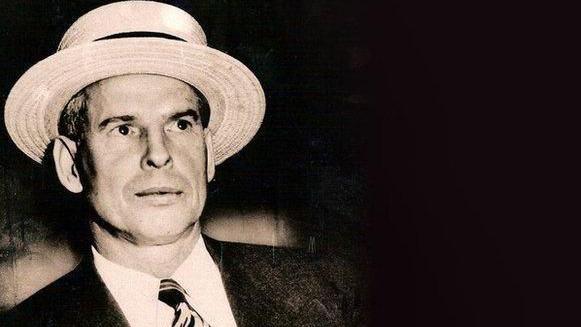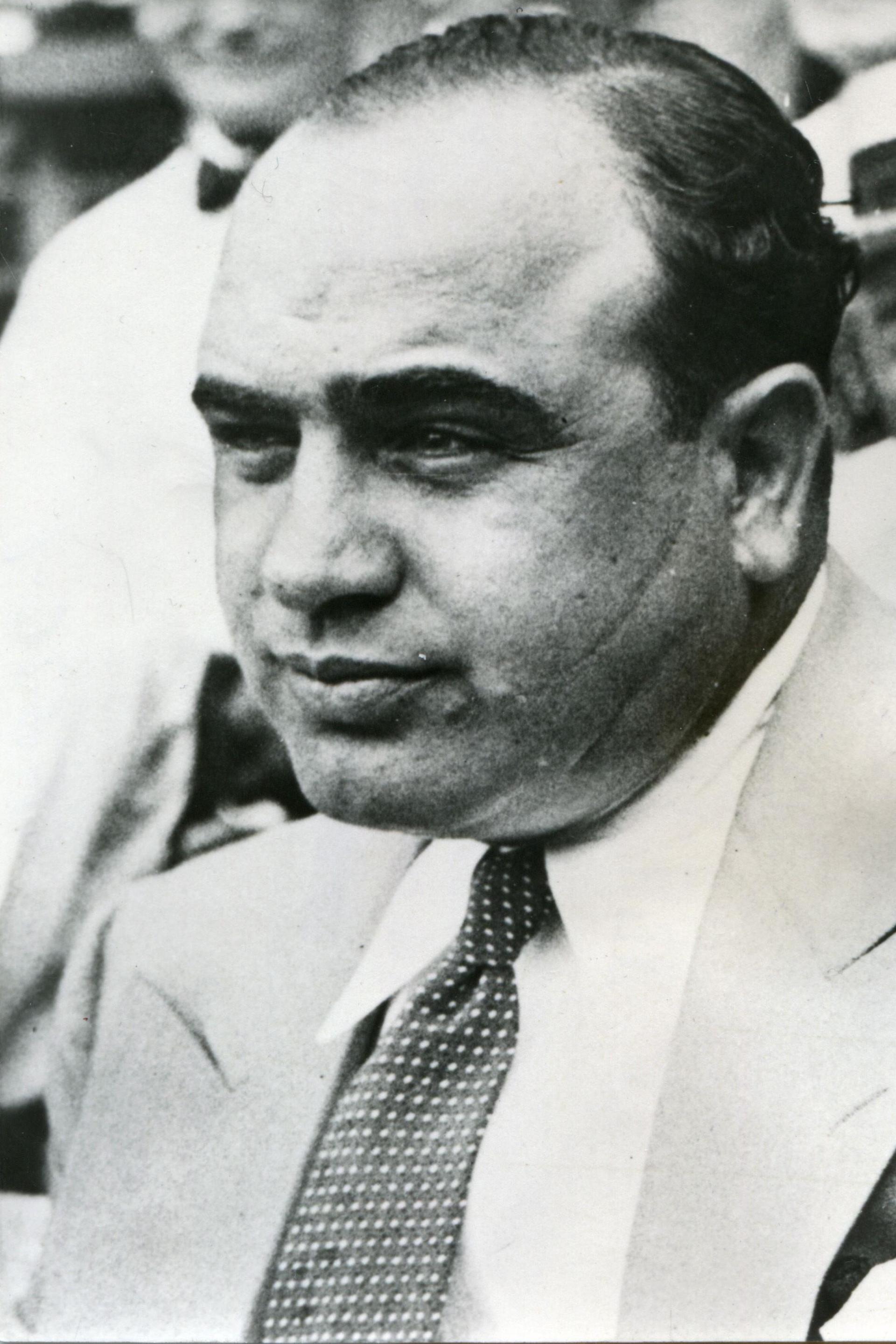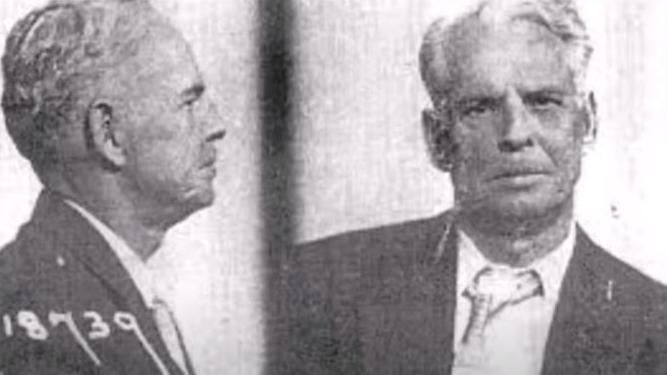The House of Lords peer whose cousin was Al Capone's right hand man

As the FBI's number one most wanted from 1947 until his death in 1965, Murray the Hump was notoriously difficult to photograph
- Published
He was the right hand man of Al Capone, one of America's most notorious gangsters, and he helped orchestrate the St Valentine's Day Massacre.
However, his roots lie in a small village in the rolling Welsh countryside and his third cousin is former Plaid Cymru leader Dafydd Wigley, who now sits in the House of Lords.
Now, on the 60th anniversary of his death, the peer has looked back at the life of Llewellyn Morris Humphreys - better known as Murray the Hump.
Even his death was seemingly tinged with the intrigue that consumed his life - a massive heart attack that posed an unanswered question about whether it was natural causes or external forces at work on the "gentleman gangster".
Humphreys' parents, Bryan Humphreys and Ann Wigley, were childhood sweethearts from Carno in Powys who already had two children before they married in China Street Chapel, Llanidloes in 1888.
Such was the hardship from an economic depression and cheap Russian grain imports, their family farms could no longer support them so the couple emigrated to Canada in 1890 before moving to Chicago, where Llewellyn was born in 1899.
Enduring mystery of New York icon with Welsh owner
- Published15 February
The dark story of the man behind Hollywood's park
- Published9 February 2020
"The family had found their feet in Chicago. Llewellyn was in a good school and his father was coach driver for a wealthy leather merchant," said Lord Wigley, who led Plaid Cymru twice in the 1980s and '90s before taking his seat in the House of Lords in 2011.
"However, Bryan's drunkenness and all-round bad behaviour saw him dismissed in 1906, meaning that Llewellyn had to drop out of school and sell newspapers on the street corners in order to subsidise the family's breadline income."
Growing up, the young Llewellyn learned about the streets the hard way - fighting for the most advantageous newspaper sales pitches with fists, baseball bats and knives.
He adopted the name Murray after a judge, Jack Murray, who took him under his wing as a teenager, while the Hump came from both his love of camel-hair coats and his surname.

Al Capone hired Murray the Hump after he hijacked one of his liquor trucks during prohibition
Aged 15, he pulled off his first jewellery heist but, not for the last time in his life, his smooth talking got him out of trouble.
Lord Wigley, whose grandmother shared common grandparents with Humphreys' mother Ann, said: "Murray was always one to use his brain first and his gun last.
"That's not to say that he wasn't a vicious criminal, but if he could see another way out without violence, he'd always prefer that path.
"Even aged 15 he managed to negotiate with the Chicago District Attorney, arguing that, if they tried him as an adult on felony charges, he'd turn up in his Sunday best and cry in the dock, earning him a sympathetic acquittal.
"But if he pleaded guilty to a lesser misdemeanour, then the DA would get a result, and he'd receive a nice letter the next day... sure enough, the day after his six-month correctional discharge, the DA received a diamond-studded gold watch in the post."

Aside from a brief prison stint in 1932, Murray the Hump remained at large until his death in 1965
This approach earned him the moniker of "the gentleman gangster" - doing deals when he could and killing when he couldn't.
In the early 1920s he audaciously hijacked one of Capone's liquor trucks when the production, sale, and transportation of alcohol was banned due to Prohibition.
When he was hunted down, Lord Wigley said he faced a no-brainer to save his own skin.
"The driver recognised him and fingered him to Capone. Ordinarily that would have meant instant shooting but again the Hump talked his way out of it, persuading Capone that he was more use to him alive than dead."

As well as being the Hump's 3rd cousin, Lord Dafydd Wigley was Plaid Cymru leader in two spells between 1984 and 2001, and also an MP and AM
Instead of a bullet in the head, the Hump became Capone's fix-it man for the next 20 years.
Such was his standing in the mob, he helped arrange the notorious 1929 St Valentine's Day Massacre, which took place on North Clark Street, where the Hump spent much of his early childhood.
The ambush saw seven members of Bugsy Moran's rival gang machinegunned against the wall of a garage, which served very little practical purpose other than to strike terror into Capone's adversaries.
Murray also monopolised unions and introduced the notion of money laundering.
This funnelling of illegal earnings through legitimate businesses was key for the Chicago mob that made hundreds of millions of dollars during its reign.

Llewella Humphreys was the mobster's only child - a concert pianist who appeared on stage with Frank Sinatra thanks to her father's mob connections
He married twice - first to Mary Clementine "Clemi" Brendle, with whom he had his only child, Llewella, in 1934 and who died in 1992.
In 1958 he married his mistress Jeanne Stacey but remained on good terms with Clemi and they even travelled to Europe together, along with Llewella, in 1964.
This was when he visited Wales for the only time in his life.
He is reputed to have hailed a cab off the Heathrow rank, telling the driver: "Take me to Carno."
Lord Wigley added that, while he was there, he granted the tenants from the four Powys farms he owned the freehold to their land.
A year later, on 23 November 1965, the now 66-year-old's Chicago home was raided by the FBI, though Lord Wigley believes he was suspecting a much worse fate than federal agents brandishing badges.
William Roemer Jr, the FBI agent who had pursued Murray for more than 20 years, recalled in his 1989 book Man Against the Mob that he'd shouted out to the Hump: "Murray, for Christ's sake, you know we're FBI agents. Put down the gun."
Lord Wigley added: "He waited for the FBI to kick in the door. Normally he'd have answered with a smile, dressed in an impeccable suit, but it seems this time he was afraid of something far more sinister, so hunkered down with a gun in his hand.
"It seems as though that FBI raid – on the relatively innocuous charge of perjury - may have temporarily saved his life."
He was released on a $100,000 bail but, while vacuuming his flat that evening, he suffered a heart attack and was found dead later that night by his brother.
But Lord Wigley doesn't believe the story ends there.
"Initial pathology reports say he had an intravenous mark behind his ear but, before that could be properly checked, his body had already been cremated, against the wishes of his will," he said.

William F. Roemer, Jr chased Murray the Hump for 20 years and wrote about their love-hate relationship in his 1989 book Man against the Mob
Lord Wigley concludes: "He was a vicious and dangerous man, but you have to view him from the perspective of an equally criminal world.
"He attempted to play by the rules... admittedly his own version of the Queensbury Rules... but nevertheless he told everyone where he stood, so it was up to you if you went with him or against him."
At his funeral, Roemer Jr took the time to speak privately to the Hump's family.
"I told them how much I respected their husband, father, and grandfather, and that I deeply regretted what had happened," he wrote.
"Then I put my hand on George's [The Hump's grandson's] shoulder and told him that he could always remember his grandfather with respect.
"He was a fine man. There was a style about the way he conducted himself. His word was his bond. I surely was going to miss him."
Related topics
- Published1 day ago

- Published18 October

- Published2 November
